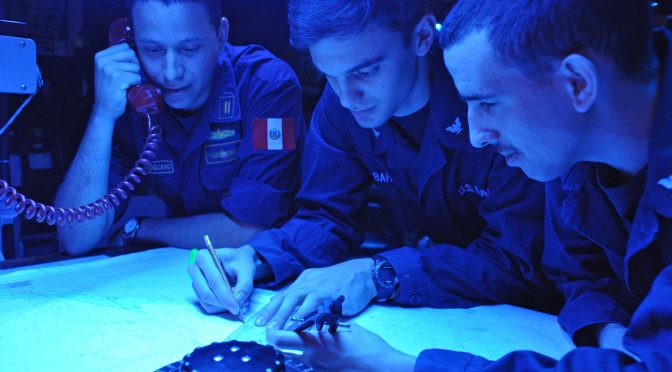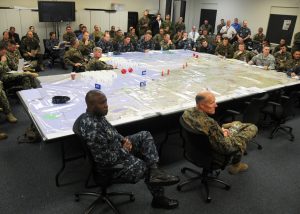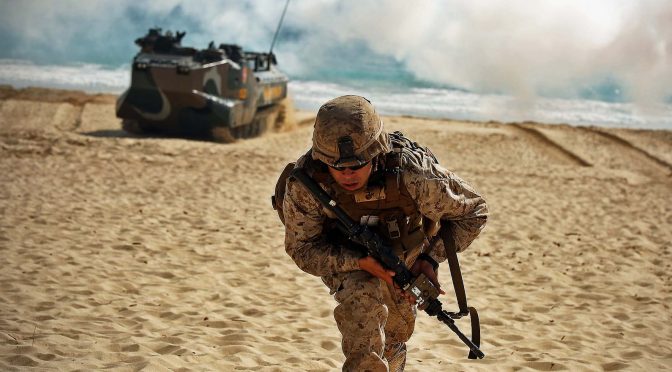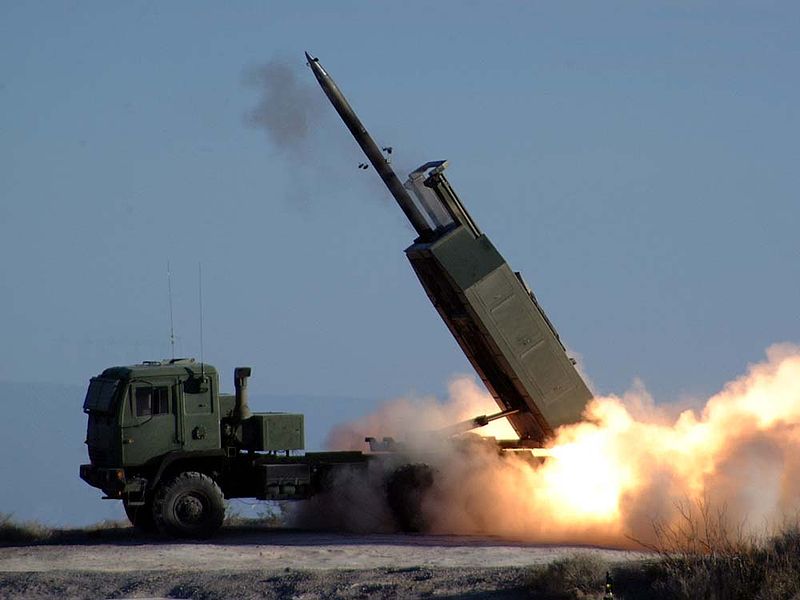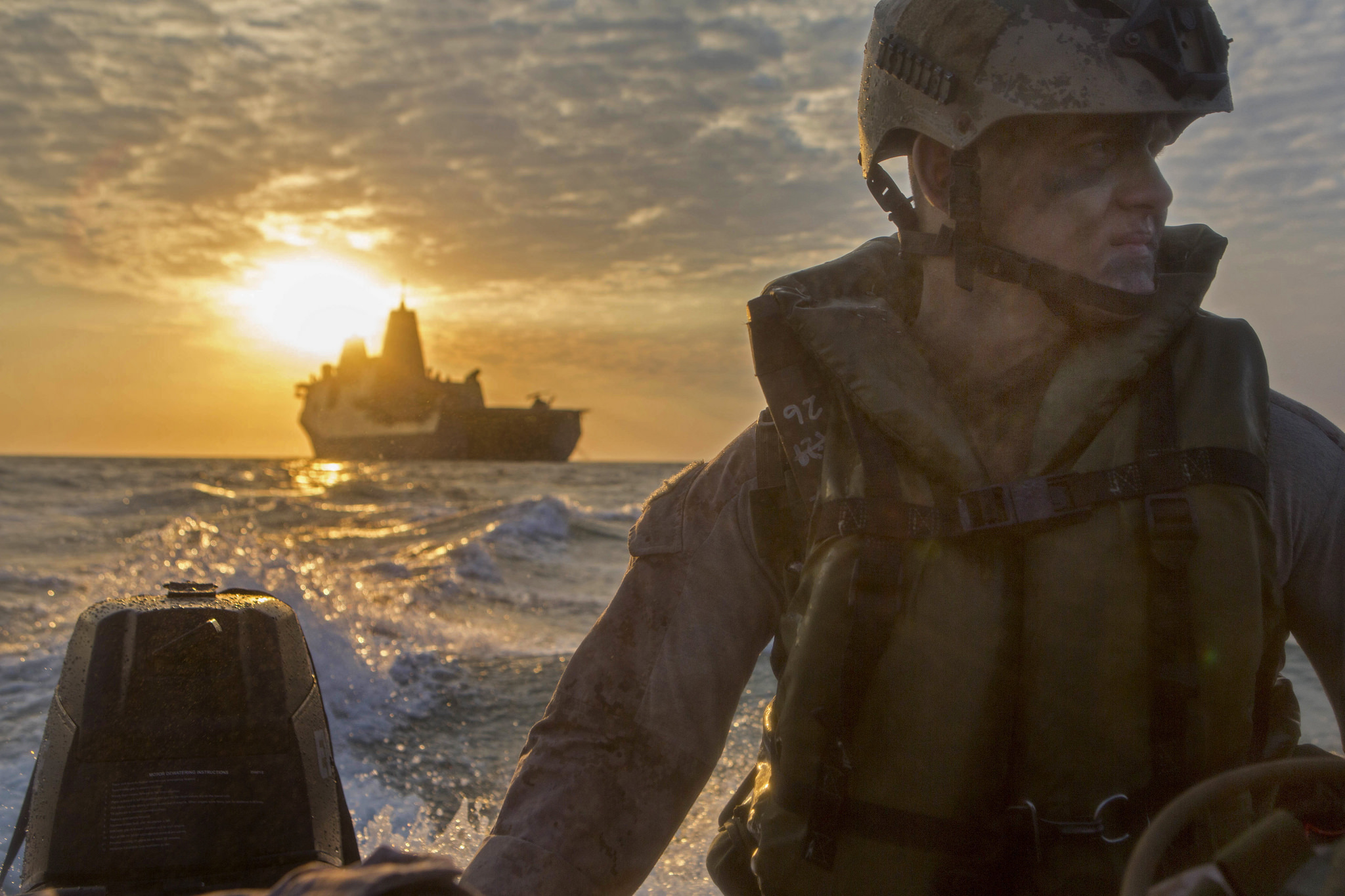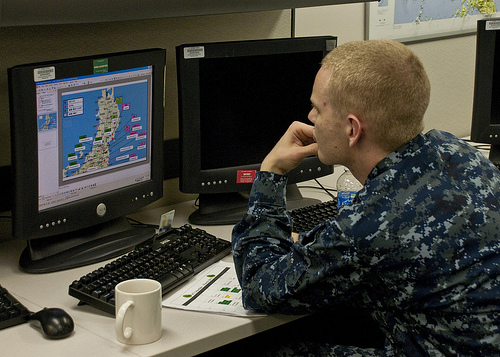By Matt Merighi
Join the latest episode of Sea Control for an interview with Professor Steve Biddle of George Washington University. Hosted by Mina Pollmann, the conversation examines the competition between A2/AD technology and the Air-Sea Battle concept in the Western Pacific. The conversation draws on an article Prof. Biddle coauthored with Ivan Oelrich, “Future Warfare in the Western Pacific Chinese Antiaccess/Area Denial, U.S. AirSea Battle, and Command of the Commons in East Asia.” Listen to the audio or read the transcript below.
Download Sea Control 130-Steve Biddle
MP: Dear CIMSEC listeners, my name is Mina Pollmann, and as Director of External Relations for CIMSEC it is my honor today to be interviewing Professor Steve Biddle at George Washington University at the Elliot School of International Affairs. Professor Biddle, thank you for joining us today.
SB: Thanks for having me.
MP: Our first question is about anti-access area-denial (A2/AD) which has become a popular concept when discussing China’s maritime strategy in the Western Pacific. What is the political and strategic motivation for China to pursue A2/AD and what are the greatest technical limitations of A2/AD? How limiting will a fully mature Chinese A2/AD capability be for U.S. operations in the Western Pacific?
SB: Denial strategies of this kind are very common historically for either weak maritime powers or rising maritime powers that are still at a disadvantage relative to a stronger foe. For example the Soviet Union during the Cold War began with an effort to protect its coast and inland waters from the U.S. Navy and only as it got stronger over time did it make any effort to project power further from its shores than that. So it’s a natural beginning point for any emerging maritime power. What makes A2/AD unique is that the particular technologies that have been emerging for the last two decades or more have the potential to take this philosophy of defending the coast and inland waters from a superior power projection capability and to push it out way beyond what would normally be considered the extent of a coastal defense strategy. If you look at the reach of modern reconnaissance, surveillance, and target acquisition (RTSA) technologies and the range of the missiles targeted by these technologies, then in fact you could imagine a Chinese A2/AD zone extending all the way out to or beyond the second island chain, a long, long way from the Chinese coast and far enough to threaten all of the U.S. major allies in the Pacific rim. If that capability were fully realized by the Chinese, it would be a major change in the geopolitical situation in the Western Pacific.
You mention the issue of potential vulnerabilities in A2/AD, as I mentioned RTSA is part of the whole concept. If you can’t find it, you can’t destroy it. The heart of this is one of A2/AD’s greatest vulnerabilities. To get the kind of all-weather, day-night, 24/7 surveillance coverage to make the most of what precision-guided missiles could do at these kinds of ranges largely requires radar. And radar is an active emitter, and as an active emitter gives away its location and makes it vulnerable to counter-attack. Many of the technologies that create A2/AD threaten A2/AD. As long-range precision guided weapons proliferate, it’s particularly easy to target transmitting, emitting radars. And if you destroy the radar you then make it much harder for the Chinese to extend the reach of these kinds of technologies to anything like the distances people talk about when they talk about the second island chain.
MP: Is the Joint Concept for Access and Maneuver in the Global Commons (JCAM-GC), previously and more commonly known as AirSea Battle, a meaningful way to deal with the A2/AD challenge? And how cost-effective is this concept compared to A2/AD?
SB: The concept formerly known as AirSea Battle, and the new concept whose name no one uses because it’s so awkward, is a natural response very much in the tradition of the way the U.S. military responds to these kinds of capabilities if you’re worried about Chinese A2/AD getting out to the second island chain: preemptively destroy it. Rather than tolerating this, the basic idea behind the concept is that we are going to reach into the Chinese mainland and destroy before they can be used the radars, the logistical infrastructure, and the mobile missile launchers that are required for A2/AD to actually reach out very far at all beyond the Chinese coast. It involves a lot more than just that idea, the bygone name of AirSea Battle was meant to harken back to the Cold War concept of AirLand Battle which was all about the Army and the Air Force combining their activities in two different domains, the land and the sky, to be more effective against Soviet forces in a potential invasion of Western Europe. The concept of AirSea Battle would similarly combine multiple domains with the Navy and the Air Force cooperating to make it easier to deal with what would be an extremely difficult problem in penetrating hundreds of miles inland to the Chinese mainland to destroy mobile targets that can hide amidst the complex background of the earth’s surface. Not withstanding all the advantages of multi-domain operations in this respect, it is still an immensely difficult project.
It seems to me that the right way to think about this project, AirSea Battle versus Chinese A2/AD, is that you have to look out beyond the immediate military balance into the fairly distant future because the technologies we are talking about won’t mature to the point where they are a serious threat to the second island chain until you get out into the more distant future.
But when you decide that to evaluate this fairly we have to look out beyond 2017, beyond 2020, the paper I wrote recently looks out to 2040, then you have to assume that both the U.S. and China are going to be engaged in a rather energetic, two-sided, adaptive competition in which they each try to thwart the other’s capabilities and where both of them are plausible economic peers after a decade or two of this competition. If you think of the competition between A2/AD and AirSea Battle as a long-term, mutually adaptive competition between economic peers, then the cost-exchange ratio becomes decisive. If the way the U.S. is going to deal with the A2/AD threat to the second island chain is to spend China into the ground, which we did successfully against the Soviet Union in the Cold-War, we are going to spend ourselves into the ground.
Where the Soviet Union was a declining economic power that you could beat in an all-out economically exhausting arms race, we are not going to be able to do that with China unless the economic projections are way wrong. So what that means in turn is if one side or the other has the cost advantage, it means that they are going to win the race if it’s fought to extremis. When you look at the details of how AirSea Battle operates against A2/AD, there is a systematic cost advantage in creating and maintaining area denial as opposed to battering it down in a preemptive strike as AirSea Battle would do.
MP: In your paper you give several concrete suggestions for the U.S. going forward, such as investing in larger, heavier missiles and an anti-ship missile with a range of at least 600km, deploying long-range mobile surface-to-surface missiles to the region, and making policy decisions to reduce U.S. reliance on space and restrict Chinese access to space. What are the greatest limitations for implementing these recommendations politically and operationally?
SB: Before I discuss the challenges let me explain very briefly why these things are important. They emerged naturally from the problem of RTSA and countering RTSA in a long-term competition. Radar is a central technology in all of this, that means defending radar and limiting the range of the opponent’s radar is critical, and much of what the paper does is talk about a long-term competition between an attempt to push radar coverage further out and an attempt by its opponents to keep it from getting further out. The modernization and acquisition agenda is driven largely by the requirements of the competition. In space, the easiest way to extend radar coverage over an arbitrarily great distance is to put a radar in space. The Soviets did something like this during the Cold War, this isn’t a particularly exotic capability. If in fact the U.S. grants military sanctuary to space what we are doing is enabling China, through space-based radar, to establish RSTA that could threaten any U.S. ally in the Western Pacific. The capability produced by the range of the missiles and the ability of terminal guidance to take advantage of that range, given surveillance that can localize targets, is very impressive.
It seems that unless the U.S. is prepared to blind Chinese space-based radar then A2/AD could undermine the entire U.S. alliance system in the Pacific. Therefore, it’s important the U.S. seriously consider both the technologies and programmatic capabilities to develop anti-satellite weapons to remove this threat, but also to think very hard about the policy issues about whether we want to wage war in space, whether we want to pursue weapons bans in orbit. The conventional wisdom of the U.S. for a long time is that space is a unilateral U.S. advantage and if we could somehow make space a demilitarized zone that this could benefit the U.S. In the emerging world of potentially very-long reach Chinese A2/AD, that older assumption that space is a unilateral U.S.-advantage is subject to serious challenge. If China has military access to space, the military prognosis in the Western Pacific could be radically different.
If you then say let’s at least take seriously the idea that the U.S. might want to deny military sanctuary in space to the Chinese, what would be involved in that is the Chinese won’t grant us sanctuary either. Anti-satellite weapons have massive cost advantages over satellites. If sanctuary is denied in space either side is going to be able to destroy satellites vastly more cheaply than either side can replace them, but that means the U.S. would have to be prepared to make war without access to space.
There’s no reason in principle why we can’t do this. All of the things that we do with space could be done with airborne alternatives such as communications relays and airborne radars for surveillance. We could, if we chose to do it, develop the capacity for redundancy where we can make war without these capabilities, but we have not expected to do that for a very long time, so it seems to me that one important acquisition priority and planning priority is to recover the ability to wage war in the Pacific without space-based assets.
This is not a popular agenda. The general thrust of U.S. force design and modernization for at least a generation, maybe two, has been to rely more heavily on space-based assets to enable smaller, more widely distributed maritime and terrestrial force structure to survive. It’s time to seriously rethink that but that’s subversive of very longstanding tradition of thinking about force design.
Also as important as acquisition and modernization issues, if you think about the military problem in the Western Pacific, you need to develop capabilities with the range needed to keep Chinese radars from venturing too far beyond China’s shores and extending A2/AD beyond what we argue in our paper is a natural limit in the neighborhood of 400-600km from the coastline. If we deploy things like long-range radiation-homing missiles that can take advantage of the range you would need to force Chinese radars back over the mainland. Similarly, A2/AD in the long-term, two-sided mutually adaptive competition is something both sides will be able to employ and should want to employ. Just as, in our view, the impracticality and the cost disadvantage of preempting Chinese A2/AD should prevent us from doing it, so China would have a cost disadvantage in trying to preempt an American A2/AD capability, and the capacity to close much of the Western Pacific to Chinese maritime traffic is an important military capability the U.S. would want to have. To do that, we need anti-ship missiles of a range for exploiting a 400-600km U.S. A2/AD bubble beyond friendly homeland masses and that will require anti-ship missiles of substantially greater range than today’s Harpoon.
MP: What really struck me was the space part of this, but as you put it this is a debate we should be having more actively and publicly. It’s going to have implications across all of U.S. security policy. To quote from your book Military Power, “In continental warfare, many great powers failed to master complicated modern-system force employment, and variations in such behavior have been more important that technology per se for observed outcomes” (43). Could you elaborate on this central finding of Military Power? How do you weigh the relative importance of technological change versus force employment?
SB: Arguably, the most important trends in land warfare or continental warfare since about 1900 has been the discovery by most great power militaries very early in the 20th century, before the end of the first world war actually, that the complexity of the earth’s surface offers enough cover and concealment to substantially shield land forces from the increasing potential lethality of modern weaponry. However, to operate a mass military of potentially millions of soldiers in a way that can exploit the natural complexity of the earth’s surface for cover and concealment means accepting tremendous complexity in tactics and operational art. Relative to, for example, Napoleonic tactics where armies could be lined up in shoulder-to-shoulder linear formations and simply marched towards an objective, if you’re going to use the complexity of the earth’s surface to provide cover in ways those massed shoulder-to-shoulder formations couldn’t do, then you’re going to have to break down those massed formations into small handfuls of soldiers few enough in number that they can fit into the folds in the earth that create what militaries ironically call dead ground, where dead ground is of course where you can live (I didn’t coin the term).
But that means you’ve got thousands upon thousands of small formations of independently maneuvering soldiers working their way through the terrain trying to find their way forward by the path that provides the most cover and the least exposure, to do that and not get caught by surprise in the open requires thousands of junior officers to have the professional training to use their own eyes, judgment, and ability to size up the terrain and ascertain likely fields of fire of enemy weapons to be able to wind through complicated terrain and find the right way forward.
Moreover, even if they do that, they are going to occasionally get caught in the open. If you are going to advance any significant distance toward a meaningful objective, sooner or later you’re going to get caught in the open. To cross those open patches of ground require suppressive fire. The weapon types best suited for suppressive fires are machine guns and artillery with access to enough ammunition to keep the enemies’ heads down as you sprint from one patch of cover to another. Access to that kind of ammunition requires location in the rear where you can safely amass that quantity of ammunition, that in turns means that not only do we have thousands of small formations lead by junior officers winding their way through complex terrain toward an objective, they are depending on coordinated activity from fire support systems that they can’t see. And they’re firing over their head or across their frontage at targets in front of them that the gunners can’t see. And if they get this just a little bit wrong, the result is catastrophe if the gunners fire a bit short they slaughter their own forces. If the gunners fire a bit long they fail to suppress the enemy and you get slaughtered when you get caught in the open. So the sheer complexity of all these moving parts and all of this communications demand and coordination requirement is a daunting undertaking for mass militaries consisting often of people who just recently were drafted into military services and have not had a 40-year military career to learn how to do this.
The net result of all that is, in principle, that the complexity of your surface can in fact substantially mitigate the nominal technical lethality of improving weapons. But only if the military is capable of carrying out very complicated techniques on the battlefield and some militaries have and others have not. And in fact the book argues that much of the variants in military outcomes in continental warfare since 1900 is attributable to variations in how well or badly any given mass military masters this very complex set of tasks, much more so than whether their weaponry was more lethal than the other side’s weaponry.
But all of that is driven at its base by the complexity of the earth’s surface and how that impacts the military environment. Now let’s transfer this picture to maritime warfare and air warfare and now the background and environment is much simpler. Obviously maritime environments aren’t as simple as the brown wooden tabletop on which the recording device is for this interview sits. There are thermoclines in the oceans, sea states can create background clutter, there are clouds in the skies, so it’s not literally transparent. On the other hand, it’s a lot more transparent than the Fulda gap in West Germany or than the Ardennes forest from the 1940 campaign.
What that means is that whereas maritime warfare can be extremely complex and A2/AD in the way we are talking about it now requires very rapid coordination among a significant range of very different pieces of equipment located in very different places–not a trivial enterprise–but by comparison with the kind of complexity we are talking about on land this is a lower order of difficulty. What that suggests is that probably in the maritime and air domain the relative contribution of technological variations to combat outcomes is likely to be greater relative to skill and mastery of the earth’s complexity by comparison with the picture on land. None of that is to suggest that tech is irrelevant on land or that skill is irrelevant at sea and in the air – certainly that is not true. But given that they both matter in both domains, the interesting question is the relative importance of these two things that both matter and I think there is very good reason to argue that the relative importance of tech is lower on land and the relative importance of tech is higher at sea and in the air above the sea.
MP: This definitely highlights the importance of innovation and tech in the maritime domain. Moving on, what strategic and operational advantages are offered by blockade versus other acts of war and how can a blockade compliment both Chinese and U.S. strategies in a Pacific conflict?
SB: Blockade has played a big role in the debate over the military balance in the Western Pacific, usually people assume that it’s something the U.S. is going to do to China, especially distant blockade at maritime straits that the Chinese would use to import oil. And it seems to my coauthor and I when we were writing the paper that, yes, that’s an important capability but that it’s too narrow a way of thinking about blockade. In particular, A2/AD is a natural blockade weapon. If you assume a two-sided long-term competition in which both sides are doing this sort of thing then the capacity of the Chinese to invade Taiwan, Japan, or other U.S. allies in the region will be very limited because our ability to exclude the logistical shipping the Chinese would need to sustain an amphibious invasion ashore would be very powerful. We think it is very unlikely that China would be able to master what is at best an extremely demanding logistical challenge, an amphibious invasion in this kind of environment.
By contrast, even if you have mutual A2/AD exclusion over an area of water, that sets up a very impressive blockade potential. Perhaps Chinese surface shipping couldn’t get access to Taiwan, but if Taiwanese surface shipping can’t get access to Taiwan, then Taiwan is looking at a potential economic catastrophe. Not only does the country’s economy depend on trade, but keeping the population fed depends on trade. In fact, many of the U.S. major allies in the region are island nations that are dependent for their very survival on seaborne commerce. If A2/AD is used to deny access to commercial shipping bound for these ports, that is potentially a very impressive coercive lever that China could use to contest control of the various territorial stakes that constitute the normal casius belli in conversations about a potential war. So we tend to focus more attention than most on the prospect of not just the U.S. blockading China but on the prospect of China blockading U.S. allies, because that looks to us like a more viable threat than amphibious invasion. It is also more viable in a variety of ways than missile-based strategic bombing.
The same tech that created A2/AD can also destroy power plants, they can destroy bridges and comms systems, and can be used to do what Americans have traditionally used airplanes to do – essentially a form of coercive strategic bombing. Whereas this hits targets that are ashore and often in close proximity to populated areas, and therefore is very likely to involve large scales of collateral damage not just to the civilian economy but also to lives, blockade need not. Blockade takes place at sea against container ships that in the modern world have remarkably small crews – it would in principle be possible for a coercive Chinese campaign aimed at the interdiction of maritime shipping to impose a truly impressive level of economic pain on U.S. allies while killing very few civilians and physically destroying very little civilian property – therefore posing substantially lower escalatory perils in a potential conflict with a nuclear armed superpower like the U.S. We think that a two-sided consideration of blockade in an A2/AD environment is an increasingly necessary part of the strategic debate.
MP: Seems politically less costly as well–the escalatory dynamics and risk of retaliation if you’re pursuing a strategy where your own troops aren’t at the front lines. The U.S. DoD is pursuing a third offset strategy to restore conventional deterrence against peer competitors with an emphasis on battle networks and human-machine teaming. In this vein, what sorts of OPCONs and capabilities do you see offsetting a mature Chinese A2/AD capability and establishing a credible deterrent in the mid- to long-term?
SB: Third offset is the flavor of the moment in the U.S. defense debate, I find it a difficult thing to evaluate in part because it’s so hard to pin down exactly what it is. Now that we have offset language floating around, the first offset was pretty easy to identity – nuclear weapons – you can analyze their effects. The second offset, precision guidance, similarly is a relatively discrete set of things that you can talk about – you can talk bout their effects in an integrated way and build out some analysis. The third offset is a pretty amorphous collection of things we think we’re going to be good at, the connection between, for example, big data and robotics, is kind of hard to pin down, so, given that it has this kind of scattered amorphous quality to it, it’s hard to produce a coherent assessment of it as a thing.
What one can do though is talk about the underlying physics of the problem when you’re looking at this long-term, mutually adaptive, two-sided A2/AD competition. And ask, what would you have to ask of AI or big data or of robotics or miniaturization, all the various bins that make up the third offset in an environment where you can reasonably expect the Chinese will be doing the same thing. At the end of the day, I don’t think any of these things overturn what we see as the central asymmetry at the heart of A2/AD versus its assailants, which is the complexity of the earth’s surface as a military environment as opposed to the water and the air. So in an environment which both sides are going to be getting better at big data, both sides will deploy AI, both sides are going to be looking at robotics with ultimately seekers and searchers in the air penetrating the Chinese mainland looking down into this complex environment to try to find things like air defense, mobile missile launchers, and logistics bases. They are looking at a background that poses a much more complicated targeting problem than they have looking up at you – you’re silhouetted against an open sky, you’re burning fuel at a prodigious rate in order to stay airborne which means you’re producing a tremendous amount of heat and you’re moving very rapidly which simplifies Doppler processing.
You look at all these things and it’s a profound and systematic asymmetry between the survivability of things that can operate on the land in the midst of this complicated environment and things that cannot. Nothing that I see in the third offset will affect that underlying asymmetry in any profound way – it may very well improve both sides ability to find each other, but it’s the difference between the two that determines the outcome of the campaign and the only source of fundamental asymmetry in this long-term, two-sided mutually adaptive competitive is the asymmetry in the military environment that one is operating in. I don’t see the third offset overturning that.
MP: What would be the strategic effect of China launching a first strike on U.S. Pacific allies and forward-deployed forces in the region in a 2040 timeframe and what could such a strike entail?
SB: The long-range precision-guided missile technologies we’re talking about may or may not have any easy time finding mobile targets. But, fixed targets are going to be increasingly vulnerable, and especially things like runways. If the U.S. deploys in peacetime large air forces or naval assets in fixed forward bases, a preemptive strike would be able to destroy whatever we choose to deploy there and it’s going to be very difficult to provide terminal defenses that will protect those kinds of targets given their static nature and the increasing capacity of long range missiles to destroy especially fixed targets.
That does not however mean that China will have the ability to destroy the U.S. military in the Pacific. If for example the U.S. responds to a crisis by dispersing aircraft, some of which will be beyond the range of Chinese A2/AD, or if the U.S. in peacetimes simply deploys the majority of its military beyond the 400-600 km plausible reach of Chinese A2/AD, China will have very limited ability to preemptively destroy any asset that we don’t deliver to them with gift wrapping on by predploying them on fixed bases within reach of Chinese missiles. Mobile targets will become very difficult to find once radar and satellites are destroyed and once airborne radars are restricted to a 400-600 km reach from the Chinese mainland. And that means that dispersed air bases for example, or aircraft carriers for sea basing, operating beyond the reach of Chinese A2/AD, will be able to provide basing assets that China will then have a very difficult time destroying. This is especially true if you posit an environment in the future in which modern airborne radar will be less relevant, a very important technology for A2/AD which was designed in an era in which the processing technology and the human crew needed to do that processing had to be carried in the airframe. In the future, improvements in microelectronic tech and high bandwidth secure comms will allow more and more of that to be offloaded to mobile ground stations, which in turn enables the airplane to be made substantially smaller and therefore able to operate from smaller and less elaborate basing structure. In fact, it’s plausible to imagine airborne radars with range comparable to that of today’s JSTARS will in the future be put on airplanes that can operate off unimproved highways. In an environment in which you can, if necessary, operate from an unimproved highway or operate from small regional airports, and in which runways repair continues to mature in the way that it has in the last two generations, it becomes harder and harder to imagine that a cost effective competition between basing attack and basing repair and basing dispersal can be won by the attacker. Assets forward deployed in peacetime and struck preemptively will be very vulnerable. Their replacements, once long-range surveillance is taken down, will be vastly more survivable.
MP: What strategic and operational benefits and limitations do Chinese naval forces incur by operating under an A2/AD envelope in the Western Pacific?
SB: We tend to believe that naval assets that venture within range of an American A2/AD zone are going to be extremely vulnerable in the same way that an American naval asset would be if they sailed into the teeth of the Chinese A2/AD system. If the competition unfolds in the way that we expect, we’re going to be looking at an environment in which surface maritime operations that reach the enemy’s A2/AD zone are simply going to be too vulnerable. What that means, however, is that naval assets can be viable if either a) they’re operating more than 400-600 km away from enemy-held land areas or b) if they’re operating in close inland waters where they’re within reach of protection by anti-missile systems that are deployed in a mobile basing mode on land that emits the complexity that I talked about earlier.
That suggests in turn though that if the way China is going to think about a future war with the U.S. is by building a seagoing blue water navy, it’s going to sally forth and extend the reach of Chinese A2/AD beyond 400-600 km which cannot threaten U.S. allies like Japan and South Korea. Instead, they may use naval assets to extend that bubble further out, but they’re going to have a great deal of difficulty enabling those surface naval platforms to survive because they’re going to have to move within reach of U.S.-friendly A2/AD capabilities deployed on allies like South Korea, the Philippines, or Taiwan.
MP: How do you envision deception operations factoring into the strategy for both those forces seeking to deny access and secure it?
In a sense, the whole analysis I just presented is premised on an argument about deception. It’s premised on the argument that the complexity of the earth’s surfaces makes things harder to find. Cleverer forms of deception, causing the corpses of convicts to wash ashore with phony orders in their pockets and so on, to take an analogy from an earlier era, have incredibly difficulty in an environment in which RSTA technologies are as good as they’re going to be. Certainly there are all sorts of forms of electronic deception that are part and parcel to these technologies, but at the end of the day, we tend to think that the power of searchers, if the environment is conducive, is going to make it harder and harder to hide unless the environment is conducive. The two-sided searcher/hider competition where the hider is embedded in the complexity of the earth’s surface is a situation in which the hider can use deception. When using deception to win if you’re a stealth bomber trying to penetrate into a heavily defended airspace silhouetted against a blank sky burning huge amounts of fuel moving at very high speed into the teeth of very powerful, mobile land based radars isn’t a deception strategy we think has much potential.
MP: Thank you so much, this was a really fantastic conversation Professor Biddle and I am excited to share this with our listeners.
SB: My pleasure.
Dr. Stephen Biddle is Professor of Political Science and International Affairs at George Washington University, and Adjunct Senior Fellow for Defense Policy at the Council on Foreign Relations. Before joining the GW faculty in fall 2012 he was the Roger Hertog Senior Fellow at the Council on Foreign Relations, and previously held the Elihu Root chair in military studies at the U.S. Army War College Strategic Studies Institute (SSI). Dr. Biddle served on General Stanley McChrystal’s Initial Strategic Assessment Team in Kabul in 2009, on General David Petraeus’ Joint Strategic Assessment Team in Baghdad in 2007, and as a Senior Advisor to General Petraeus’ Central Command Assessment Team in Washington in 2008-9. He has served as a member of the Defense Department’s Defense Policy Board, and has presented testimony before congressional committees on issues relating to the wars in Iraq, Afghanistan, and Syria; force planning; conventional net assessment; and European arms control. His book Military Power: Explaining Victory and Defeat in Modern Battle (Princeton University Press, 2004) won four prizes, including the Council on Foreign Relations Arthur Ross Award Silver Medal for 2005, and the 2005 Huntington Prize from the Harvard University Olin Institute for Strategic Studies. His other publications include articles in Foreign Affairs, International Security, Survival, The Journal of Politics, Security Studies, The Journal of Strategic Studies, The Journal of Conflict Resolution, International Studies Quarterly, The New Republic, The American Interest, The National Interest, Orbis, The Washington Quarterly, Contemporary Security Policy, Defense Analysis, Joint Force Quarterly, and Military Operations Research; shorter pieces on military topics in The New York Times, The Washington Post, The Wall Street Journal, The Atlantic Monthly, and other news outlets; various chapters in edited volumes; and 31 SSI, IDA, and NATO reports. He co-directs the Columbia University Summer Workshop on the Analysis of Military Operations and Strategy (SWAMOS), and has held teaching and research positions at Columbia, the University of North Carolina at Chapel Hill, the Institute for Defense Analyses (IDA), and Harvard University’s Belfer Center for Science and International Affairs (BCSIA). His research has won Barchi, Rist, and Impact Prizes from the Military Operations Research Society. He was awarded the U.S. Army Superior Civilian Service Medal in 2003 and again in 2006, and was presented with the US Army Commander’s Award for Public Service in Baghdad in 2007. He holds AB (1981), MPP (1985), and Ph.D. (Public Policy, 1992) degrees, all from Harvard University.
Mina Pollmann is CIMSEC’s Director of External Relations.
Matthew Merighi is the Senior Producer for Sea Control and the Host of Sea Control: North America. He works as Assistant Director of Maritime Studies at the Fletcher School of Law and Diplomacy. Contact him at seacontrol@cimsec.org.


